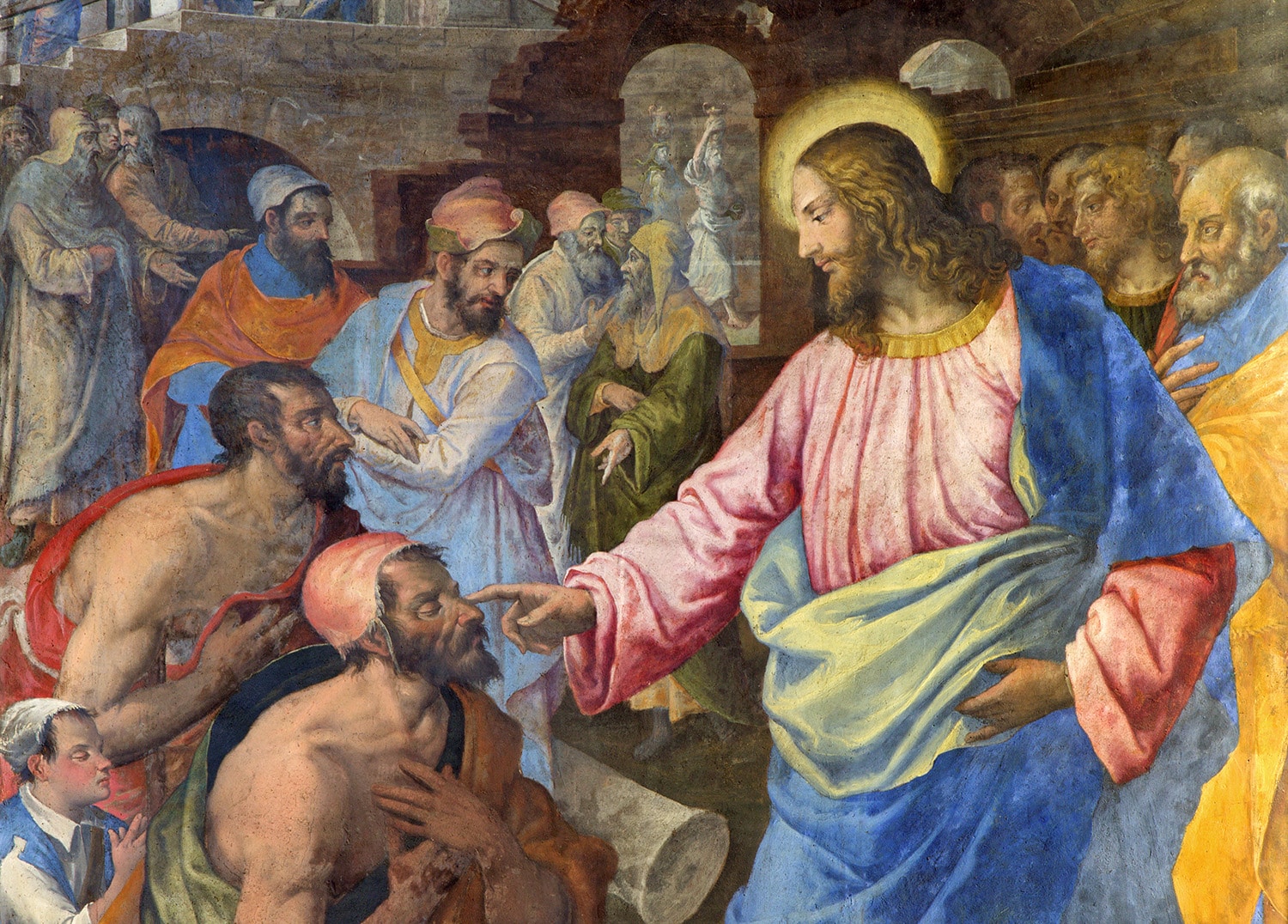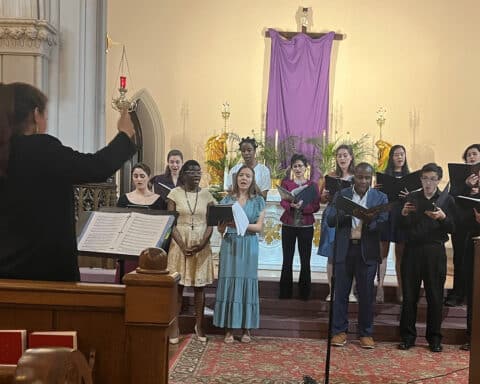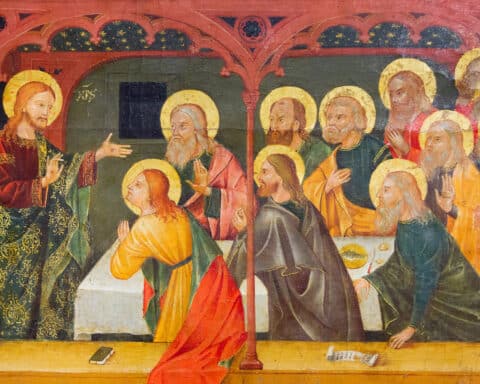The Lord looks down from heaven,
he sees all the sons of men;
from where he sits enthroned he looks forth
on all the inhabitants of the earth,
he who fashions the hearts of them all,
and observes all their deeds.
— Ps 33:13-15, RSV
Too many of us worry too much about how others see us and little about how the Lord sees us. Perhaps it is easier to occupy ourselves with concerns over the gaze of other people because we can see their eyes looking back at us. We do not happen to catch the Lord looking at us in the same way, with eyes that we can see and a gaze that we can decipher and comprehend. On an average day, it is likelier that if we consider the Lord’s regard for us, we imagine some kind of inherent knowledge he has of us rather than anything like an act of seeing, of perceiving. It is hard to imagine what we have not in some way encountered.
And yet, were we to become more attentive readers of the Gospels, we might be surprised to notice that the gaze of Jesus is featured numerous times, and always with great importance. It is the way he looks on others as well as the fact that he is the one seeing something that makes all the difference in the given episodes.
Passages to take to prayer
I read the Gospels many times before I really started to pay attention to these kinds of details, but once I noticed them, they bore significant impact in how I was able to imagine the Lord’s act of perceiving — of actually seeing — a disciple like me. Allowing the vision of his gaze to become more vivid and real is a revolutionary endeavor because what we see in his eyes is who we really are. We may see who we have been or who we might become, but we are always given the gift of seeing precisely who we are now, to him. Who we are to him is everything.
The Lord’s vision of us is always primary. Beloved, sinful creatures that we are, we tend to hide from him. In an encounter such as in Eucharistic adoration, we are called to present ourselves to him. He rests before us, waiting for us, and the key is to let him see us as we are. But to learn to see ourselves from his perspective (rather than from our own perspective or from that of others), we must become ever more familiar with how Jesus has looked upon others like us, and thus how he might and does look upon us now. This is why the accounts of the gaze of Jesus in the Gospels are so crucial: We encounter the revelation of the manner and the impact of the Lord’s gaze upon his disciples and would-be disciples.
This is why the accounts of the gaze of Jesus in the Gospels are so crucial: We encounter the revelation of the manner and the impact of the Lord’s gaze upon his disciples and would-be disciples.
Studying and then imagining the gaze of Jesus as revealed in the Gospels is where our understanding of how the Lord looks on his people may grow. In our study and imagining, we may slowly come to recognize ourselves as the ones the Lord is yearning to see. His look is not always comforting, but it is always true, and the way to true happiness begins with discovering ourselves as the ones who are looked upon by the Lord.
Perhaps you would like to choose one of the ways presented below of how Jesus has looked upon his people to focus your mind, attune your heart, and shape your imagination during your time of prayer, such as at Eucharistic adoration, during an examination of conscience or for prayer journaling. You may select a different way for different periods of prayer, or else return time and again to one that is particularly fruitful for you. The gift and the challenge is to grow in trust that the Lord who looked upon each of these people in these particular ways is the same Lord who looks upon you now, as you are.
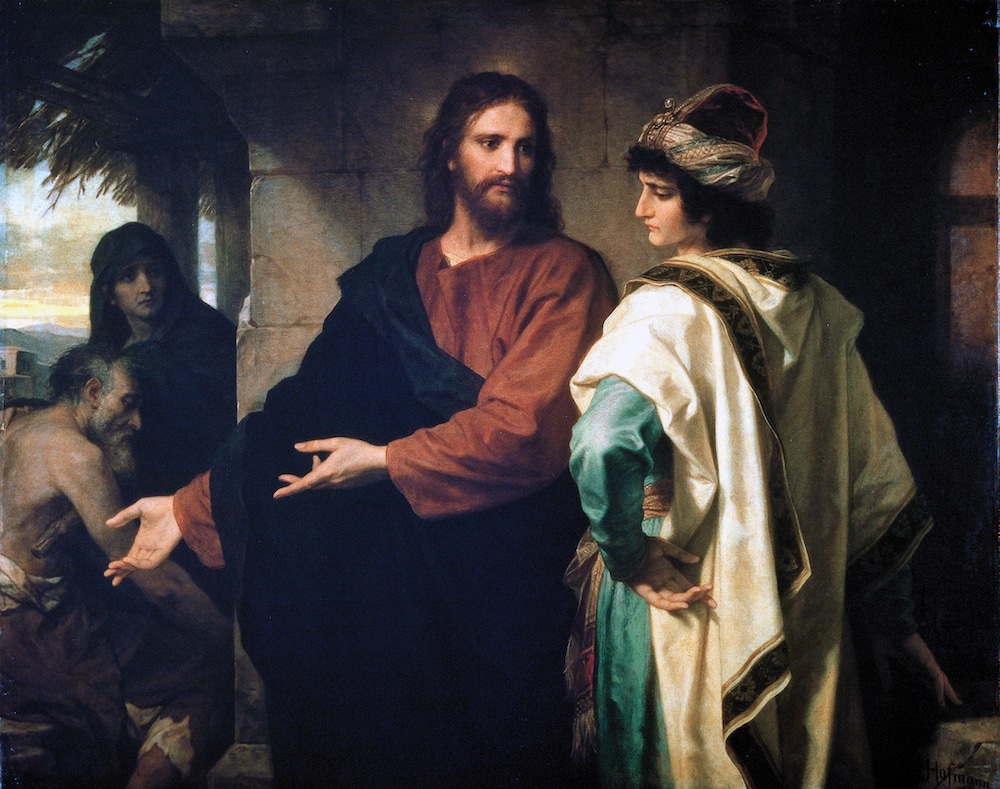
The rich young man
“And Jesus looking upon him loved him, and said to him, ‘You lack one thing; go, sell what you have, and give to the poor, and you will have treasure in heaven, and come, follow me.'”
— Mk 10:21, RSV
The rich young man came to Jesus searching for the secret to eternal life. Jesus knew what this young man really valued, and Jesus had to tell this young man something very challenging. It is with a look of love that Jesus tells him the hard and necessary truth: you cannot put God first until you stop clinging to your possessions above all else.
This is indeed the hard truth because changing his priorities will require the rich man to give what is most precious to him to those who are most precious to God: the poor. This is how he will be converted into the love of God, where eternal life springs: by loving those whom God loves.
It can be painful to see this gaze of Jesus. His gaze, filled with love, also brings a command. He sees what his would-be disciple prefers to eternal life, and his command is to let that go to make room for love of him. Letting go hurts; even the thought of letting go hurts.
Upon the gaze and the words of Jesus, the rich man’s “countenance fell.” He stopped looking at Jesus; he no longer gazed on his face. Walking away, he hid from the Lord, putting his many possessions between himself and the look of the one who loves him.
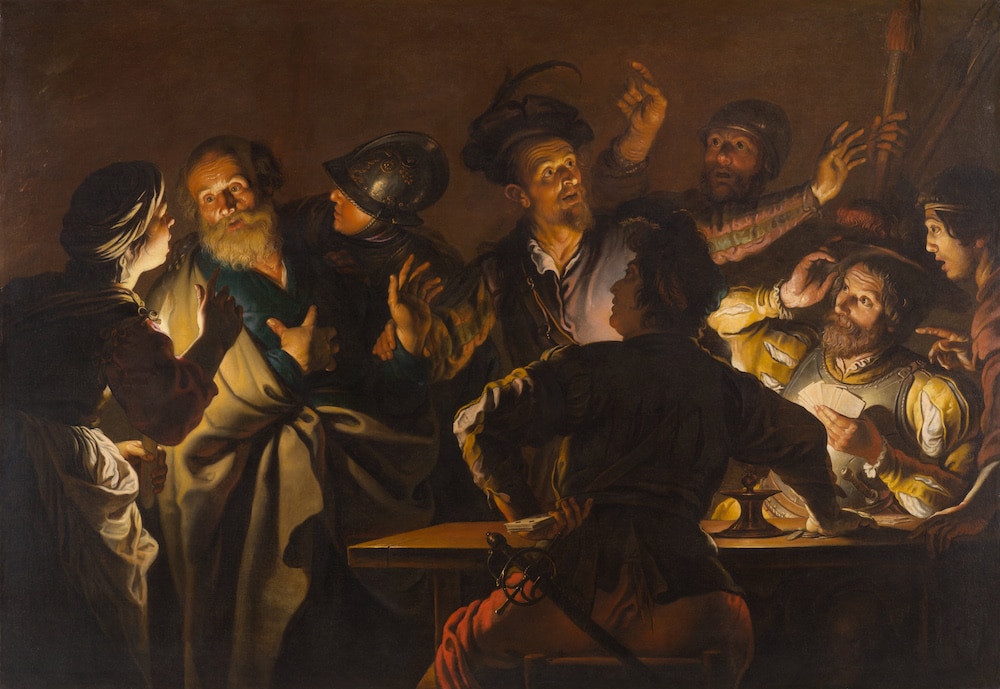
Peter’s denial
“The Lord turned and looked at Peter. And Peter remembered the word of the Lord…
[And Peter] wept bitterly.”
— Lk 22:61-62, RSV
It is when Peter saw the Lord look at him that the knowledge of what he had done filled him with shame. Jesus’s look was not a look of condemnation, but of revelation: Peter was revealed to himself by the Lord’s vision of him — it was his examination of conscience. He encountered his own act of rejection, his own failure to love the Lord who loves him to the end. This is rock bottom for Peter; it is also the beginning of redemption. The first requirement of redemption is to see sin as sin, and this is Peter’s moment of recognizing his sin. The sin Peter saw in himself is the sin the Lord will later forgive (cf. Jn 21:15-19).
The Lord is the one who forgives and redeems in truth, fully and completely from the bottom up.
When reflecting on this scene, the creators of the Notre Dame Folk Choir’s stunning choral performance “The Passion” imagine Peter suddenly recollecting his earlier failure upon the sea, when the Lord called him to himself. Peter had walked by faith across the water, but when he looked away from the Lord he began to sink. It was a foreshadowing of his true sinking, when he departed from the Lord by his denial for his own protection and security. It is when the Lord turned and looked at him that he saw himself for what he truly was, remembering the word the Lord had spoken to him. The Lord only deals in truth, not in evasions or excuses. That is because the Lord is the one who forgives and redeems in truth, fully and completely from the bottom up.
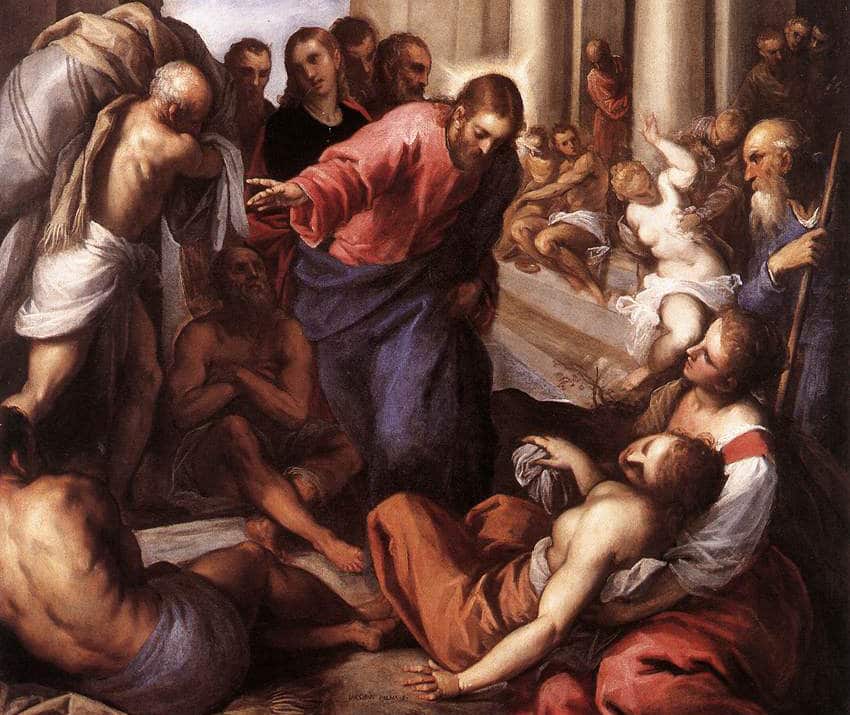
The paralyzed man
“And behold, men were bringing on a bed a man who was paralyzed, and they sought to bring him in and lay him before Jesus, but finding no way to bring him in, because of the crowd, they went up on the roof and let him down with his bed through the tiles into their midst before Jesus. And when Jesus saw their faith he said, ‘Man, your sins are forgiven you.'”
— Lk 5:18-20, RSV
There was a paralyzed man who could not bring himself to Jesus, so his friends carried him instead. They could not get in the house where Jesus was because it was so full. Undeterred, they cut a hole in the roof to lower their friend down to Jesus. It is when Jesus saw their faith — the faith of the friends — that he was moved to mercy for the man. First, he forgives the man of his sins, then he heals him of his paralysis. Great indeed is the Lord’s regard for the petitions people offer for the good of others. The Lord looks upon our concern for one another with great tenderness, responding to our concern with his mercy.
As Pope Francis writes in Evangelii Gaudium, the task of the Gospel and the work of evangelization is “to desire, seek and protect the good of others” (No. 178). An evangelizer’s heart is “full of people” (No. 281). When these friends brought the paralyzed man to Jesus, Jesus not only saw their action but he also saw their hearts. They carried their concern for the wellbeing of their friend in their hearts. This was the pleasing offering, which the Lord blessed.
| ‘Lectio divina’ |
|---|
| Catholics are used to hearing Scripture during the Mass but are often not taught how to pray with it during their personal prayer time. Lectio divina — meaning “sacred reading” — is an ancient prayer practice that helps guide the faithful through a passage of Scripture to better enter into it and receive what the Lord might desire to reveal to them through the scene.
Here’s how to pray using lectio divina:
|
‘What do you seek?’
“Jesus turned, and saw them following, and said to them, ‘What do you seek?'”
— Jn 1:38, RSV
Two disciples of John the Baptist were curious about Jesus because of what John said about him. Jesus saw them following him and asked them what they were looking for. The Word who became flesh cares quite a lot about what those who seek him actually want. So he asks.
This is the question that Jesus asks every would-be disciple, and, really, it is a question that never fades away. What do we really want to find? What do our hearts desire? What would we be willing to accept? These are the questions Jesus asks to all who seek him, each time we seek him, for as long as we seek him.
Nathaniel’s genuineness
“Jesus saw Nathaniel coming to him, and said to him,
‘Behold, an Israelite indeed, in whom is no guile!'”
— Jn 1:47, RSV
The serpent in the garden was full of guile (cf. Gn 3:1). To be full of guile is to hide what you are really about. It means holding a secret agenda and plotting with schemes. Jesus looked upon Nathaniel and saw that he was honest. Nathaniel said what he meant, he meant what he said, and he was genuine in how he presented himself. In this way, he is a model for how to let oneself be seen by the Lord. The Lord shouts for joy when he sees us like that.
How do those of us who have practiced guile time and again, seeking out our own benefit over others, making excuses, justifying false deeds, and being regularly fearful of transparency — how do we shed ourselves of our guile? There is no shortcut; we must practice regular confession: “through my fault, through my fault, through my most grievous fault.” That is the way in which sinners learn to tell the truth. The Lord calls sinners to truthfulness, so we may encounter him rejoicing at our approach.
| Ignatian prayer |
|---|
| Another form of praying through Scripture is Ignatian meditation. Contemplative, or imaginative, prayer is a method of meditative prayer developed by St. Ignatius of Loyola in which you imagine yourself as a character in a Bible story, experiencing the events described in the passage as if you were actually there.
In “Imagine You Walked with Jesus” (OSV, $17.95), you’ll learn the method of imaginative prayer developed by St. Ignatius five hundred years ago. Then you’ll be guided through 40 Gospel-based encounters with Jesus, from his birth to his resurrection. Find this book and other prayer resources at osvcatholicbookstore.com. |
Healing at the Bethesda pool
“One man was there, who had been ill for thirty-eight years. When Jesus saw him and knew that he had been lying there a long time, he said to him,
‘Do you want to be healed?'”
— Jn 5:5-6, RSV; cf. Lk 13:10-13, Jn 9:1-3 RSV
This man had been ill for thirty-eight years, and every day was more of the same: no one healed him. But this day was different because this was the day the Lord saw his illness. Being seen by the Lord was the beginning of something new, and the moment came when the man had to say that, yes, he did want to be healed.
It seems obvious that one who is ill would want to be healed, but is it as obvious as it first seems? Sometimes what is most difficult is truly desiring what is good for us and agreeing to let someone do for us what we cannot do for ourselves. Jesus sees that here with this ill man. The crucial question follows what Jesus sees: it matters if the man wants to be well. Jesus sees he is ill, he sees he needs healing, and he sees that this man must accept healing if he is to be well.
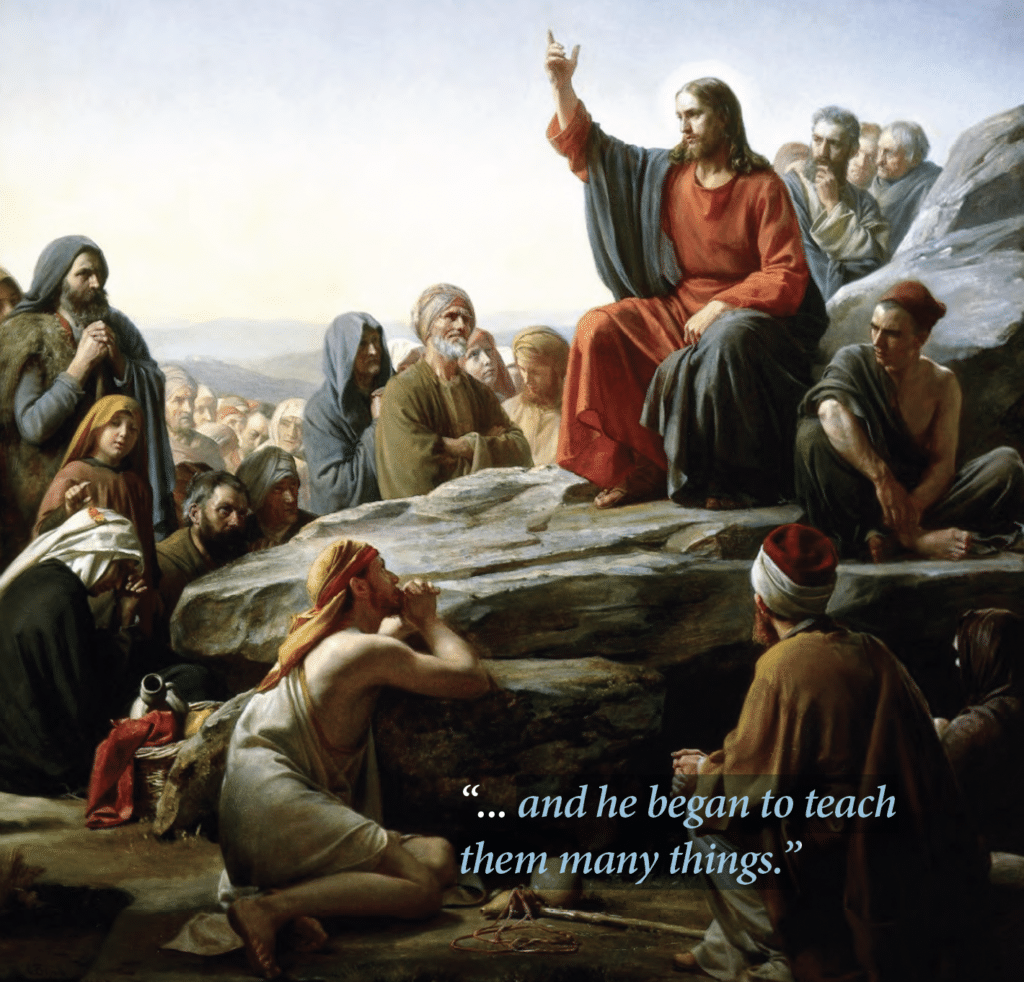
Sheep without a shepherd
“As he landed he saw a great throng, and he had compassion on them, because they were like sheep without a shepherd; and he began to teach them many things.”
— Mk 6:34, RSV
What are sheep like without a shepherd? Simply put: They are helpless. They cannot feed themselves, they cannot protect themselves, they cannot care for themselves. They wander off and scatter and become prey for predators. This is how Jesus sees the people who have followed him across the lake “to a lonely place.” Eventually, he will recognize their hunger late in the day, and he will multiply loaves and fish for them to fill them abundantly. But before that, he teaches them, then he situates them in groups upon a pasture. He sees both their immediate needs (they need instruction, order, food) and their ultimate need (they need a shepherd who will care for all their needs).
When Jesus looks upon his people, he looks with compassion. He sees our immediate needs and our ultimate needs.
When Jesus looks upon his people, he looks with compassion. He sees our immediate needs and our ultimate needs. He desires both kinds of needs to be brought before him. He wants to see it all. And he wills to respond to all that we need, if we will but follow him and heed his voice.
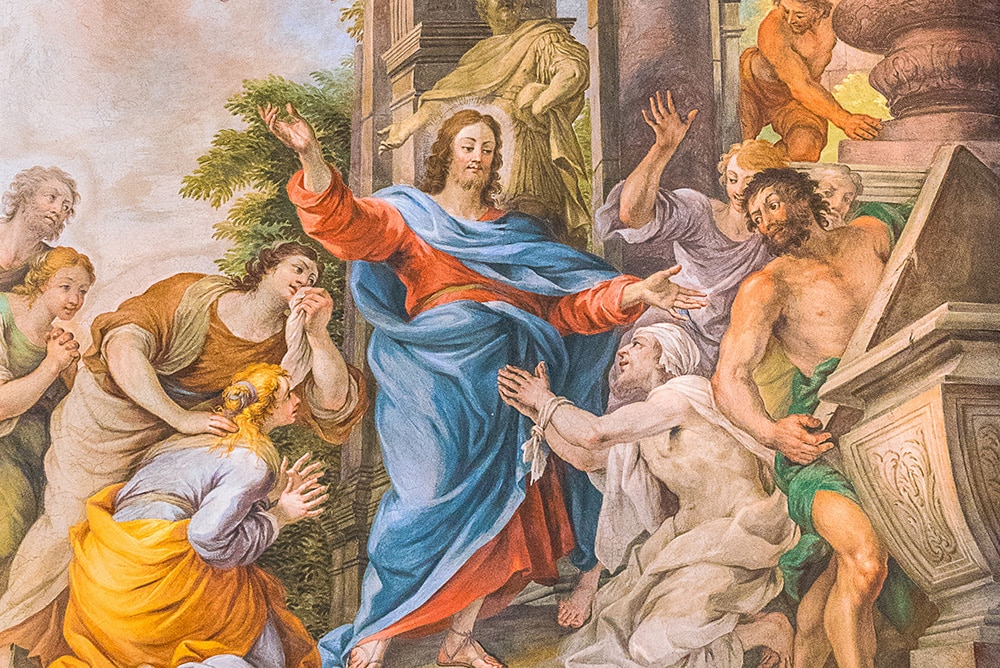
Raising of Lazarus
“When Jesus saw her weeping,
and the Jews who came with her also weeping,
he was deeply moved in spirit and troubled.”
— Jn 11:33 RSV; cf. Lk 5:1-7 RSV
Jesus saw Mary’s grief over the death of her brother, Lazarus, and he shared in her grief. But Jesus also saw the fickleness of the crowd and was troubled by their fickleness. It is the members of this same crowd — who came to him weeping — that will immediately report him to the Pharisees when they see him raise Lazarus from the dead (cf. Jn 11:45-46). He sees what is true and what is false, what is compassion and what is calculation. The Lord joins the sorrowful and judges the schemers.
What appears to be the same action in two people can, in truth, be seen very differently in the eyes of the Lord. He looks not just upon the “what” but also the “why.” He will always be close to the brokenhearted (cf. Ps 34:18).
| Wisdom from Pope Benedict XVI |
|---|
| “I would like in particular to recall and recommend the ancient tradition of lectio divina: the diligent reading of Sacred Scripture accompanied by prayer brings about that intimate dialogue in which the person reading hears God who is speaking, and in praying, responds to him with trusting openness of heart (cf. Dei Verbum, n. 25). If it is effectively promoted, this practice will bring to the Church — I am convinced of it — a new spiritual springtime.”— Pope Benedict XVI |
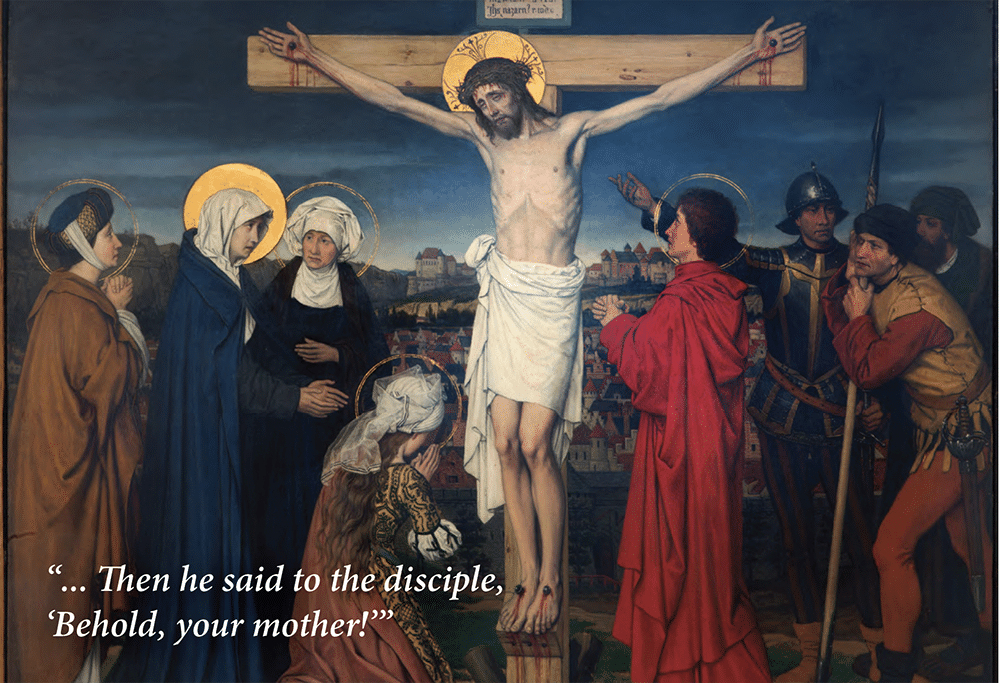
‘Behold, your mother
“When Jesus saw his mother,
and the disciple whom he loved standing near,
he said to his mother, ‘Woman, behold, your son!’
Then he said to the disciple, ‘Behold, your mother!'”
— Jn 19:26-27 RSV
In the midst of loss and absence, the Lord sees communion. He gives his mother to those whom he loves. He gives those whom he loves to his mother. He sees the love that will make us whole. By his body and his blood, with the gift of his word, he calls life out of death. “You are my friends if you do what I command you” (Jn 15:14, RSV), and he commands us to love those whom he gives us to love.
The Lord sees who in our midst is in need of our love. His command is to love those whom he sees in mercy. Our prayer is to ask him to show us who he sees, and then to strengthen us to do what he wills.

